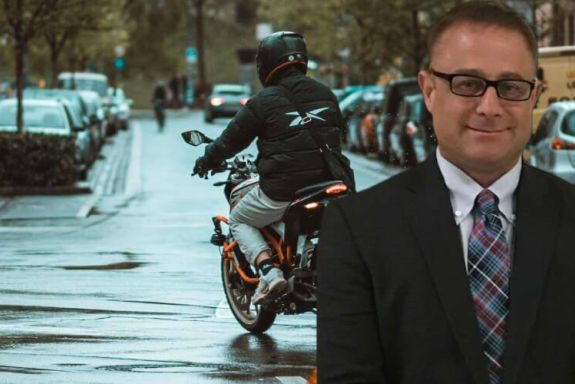
Los Angeles Bad Weather Motorcycle Personal Injury Lawyers
Over $150 Million Won

If we don’t win, you don’t pay.
NO WIN – NO FEE

ON CALL 24/7

U.S. Marine

Most accidents in California, especially in Los Angeles, occur due to negligent drivers. However, bad weather frequently plays a role in the number of motorcycle accidents across the state. Heavy rain can make the roads slippery and reduce visibility, causing motorcycles to slip. This can lead to serious accidents if the motorcyclists are not careful. Rain can also cover visible potholes, cracks, debris, and road defects, making it difficult for riders to evade them and putting them at greater risk of severe injuries.
How Should Motorcycle Riders Prepare for Bad Weather?
Motorcycles are small, lightweight vehicles that can be very difficult to maneuver and maintain balance in bad weather. Hence, our personal injury attorneys advise avoiding travel whenever possible in adverse conditions. However, sometimes motorcyclists find themselves caught in certain adverse weather conditions, and taking precautionary steps in advance can be the difference between life and death.
Pre-ride inspections and scheduled maintenance are important in ensuring your motorcycle rides safely in bad weather. Inspecting your tires every time before your trip can give you an idea of whether or not your bike can handle wet or cold weather. A great thread depth for tires is essential for riding in wet weather and breaking the water on the road.
The pre-ride inspection gives you a holistic view of your motorcycle’s health. Pre-ride assessments include checking all your motorcycle’s lights, such as tail, brake, and indicators. These lights are necessary to increase visibility and reduce accidents if properly used.
Motorcycles do not handle bumps well, and an excellent suspension system can reduce the impact of spots and provide more stability during the ride. Nasty shocks, however, can make riding over poorly maintained roads challenging, especially during bad weather.
Good brakes can reduce the stopping distance, helping riders evade accidents, and checking your brakes before a trip can help you understand the condition your vehicle’s brakes are in. If they’re not strong enough, you would want to ride slowly to your destination before having a local mechanic look at it. Sometimes air bubbles in the brake system can negatively affect the motorcycle’s braking, which is why motorcycle owners need to bleed their brakes before a long journey.
Bad weather can strike at any time, and it is crucial for riders to always be ready for adverse conditions to ensure their safety. Riders should check the weather forecast before their trip and plan the journey accordingly.
Coating the helmet with water-repellant solutions to improve visibility during the ride and wearing proper rain gear such as gloves, boots, and a raincoat can make the journey less challenging.
Tips for Riding a Motorcycle in Bad Weather
We have already discussed how critical pre-ride checkups are, but what if you’re riding a motorcycle and it starts to rain heavily? Here are some tips our attorneys have compiled for riding a bike in bad weather to reduce the chances of a motorcycle accident.
- Riding through standing or moving water is terrible, as the water can enter the exhaust system and cause motorcycles to stall. If there is no other choice but to ride through a body of water, we recommend riding slowly down the center of the road as the water is at its shallowest and trying to follow other cars rather than going in alone.
- Braking on wet pavement or surfaces can cause your motorcycle to slip, resulting in injuries. You mustn’t brake or accelerate heavily when riding a bike in bad weather to avoid slipping.
- Most of the time, visibility is poor during adverse conditions, so it is essential that you ride slowly and monitor your surroundings. If the visibility is next to zero and you cannot see the road in front of you, it is best to turn around and follow an alternate route.
- Although a helmet does not completely eliminate injuries, it reduces the chance of receiving injuries. Before your ride, equip yourself with all the necessary protective gear, such as a leather jacket, boots, gloves, and a helmet, to prevent or reduce the chances of injury during an accident.
How to Ride in Rain
Riding in continuous heavy rain is much different than simply riding on wet surfaces, as motorcycle riders are seriously exposed to all sorts of elements. Riders should go easy on the brakes and avoid unnecessary accelerations, which can cause hydroplaning. The aim should be to have smooth control over the motorcycle and make complete turns before accelerating.
Wet weather conditions affect the stopping distance, making it more challenging for riders. Motorcycle riders must have the skills to anticipate when to brake and accelerate to avoid skidding and slipping.
Braking when cornering or making turns can also lead to slips, so instead of braking, use the engine brakes by slowing down the speed and lowering gears to provide better traction.
How to Ride in Cold or Inclement Weather
Motorcycle riders are generally aware of the hazards of riding a motorcycle with cold tires. Cold temperatures can cause a significant drop in motorcycle tire pressure, increasing the risk of cold tire accidents for unsuspecting riders.
Riding with uninflated tires can cause heavy steering, internal tire damage, and sluggish handling, leading to an increased risk of motorcycle accidents. Given the risk of cold tires, motorcyclists must check the tire pressure before riding.
Not only does cold weather affect the vehicle’s tires, but it can also affect the rider too. Without adequate warm clothing, riders run the risk of hypothermia and frostbite. If you find yourself shivering while riding your motorbike, immediately head indoors to a warm place and change into dry clothes. Hypothermia can be deadly if not dealt with immediately and affect coordination, reflexes, and even energy levels.
Before riding into the cold weather, motorcyclists should wear warm waterproof clothing, covering their noses, hands, and other exposed parts of their bodies.
How to Ride in Hot Weather Conditions
Bad weather includes not only cold and rain and also hot weather conditions, which can pose a serious risk of accidents to riders if they are not careful.
While riding on a hot summer day, riders must always stay hydrated. An international study conducted found that dehydration causes similar effects to drunk driving. Motorcyclists riding their motorbikes were more prone to making errors, and the results were similar to those with a blood alcohol content of 0.08.
Besides proper hydration, it is also important to dress appropriately. Avoid wearing warm clothes, but at the same time, avoid wearing shorts or clothes that leave the skin exposed. Overexposing your skin to the sun can cause serious sunburns, and even a minor motorcycle accident can lead to severe road rash injuries.
Motorcyclists should also remain aware of heat-related illnesses to identify them if they’re experiencing one and take immediate action, as it could cause them to lose control of their vehicle.
How to Ride in Strong Winds
Since motorcycles are lightweight vehicles, they are susceptible to strong side winds. In such situations, riders should slowly lean into the crosswind, allowing them to stay upright rather than lose balance. However, once the crosswinds stop, riders should be ready to adapt almost immediately.
Crosswinds can seriously threaten riders, which is why some riders prefer to ride next to cars to avoid clashing with the wind. However, this is extremely dangerous and exponentially increases the risk of a motorcycle accident as the motorcyclist is riding in the other vehicle’s blind spot.
Bad Weather-related Accidents and Liability
Since California has a comparative negligence law, somebody must be responsible for an accident resulting in injuries to you. Furthermore, the state is also a comparative liability state, which means that the injured victims can hold more than one party responsible for their loss. The law awards compensation based on the degree of fault.
If a rider gets involved in a bad weather accident, they may be responsible for the injuries as they did not take the necessary precautions before the accident. However, if the rider is taking the necessary bad weather precautions and still gets into a bad weather accident due to a negligent driver, they may be eligible for compensation.
In such situations, having a personal injury attorney on your side is important to evaluate your case, gather evidence against the negligent driver, and pursue maximum compensation for your loss.
How California Motorcycle Accident Attorneys Can Help You
The major factors that cause accidents during bad weather are overspeeding, not allowing for enough distance between other vehicles, and slippery road conditions. A motorcyclist must have sufficient skills to adapt to weather changes quickly.
For example, during a sudden downpour, riders must immediately change their driving style by reducing speed, allowing the sufficient distance between cars, and exerting extreme caution by steering clear of potholes, debris, and poorly maintained roads.
It is not just the precautions that can help reduce the risk of motorcycle accidents but also the riding experience a motorcyclist has. An experienced motorcycle rider can navigate through bad weather conditions. In situations where the conditions worsen, the experienced rider can make a quick judgment call and stop at a safe place until the weather settles.
If you’re an inexperienced rider, you should not take the risk of riding into bad weather conditions and instead decide to stop. Remember, if the situation is beyond your control, pull over at a safe spot and wait for the weather to return to normal. Riding into the unknown can cause an accident and hold you liable for the damages.
A skilled California motorcycle accident attorney could help recover compensation if the accident was due to another driver’s negligence. Suppose you got involved in a bad-weather motorcycle accident that was not your fault. In that case, a California motorcycle accident attorney could help investigate the case and fight for your right to maximum compensation.
Contact Ehline Law for a Free Consultation
Ehline Law and our personal injury attorneys have over 30 years of collective experience helping injured victims and delivering superior results across Northern and Southern California. Our attorneys remain committed to fighting for your rights and helping recover monetary compensation for medical bills, lost wages, pain, suffering, and other damages.
If you received injuries in a motorcycle accident due to somebody else’s negligence, contact us at (213) 596-9642 for a free consultation on your case. Our attorneys will listen to your side of the story, gather evidence against the negligent party, and hold them accountable for your loss. Contact us now for more information.
- Motorcycle Accident
- ATV Accidents
- Common Causes of Motorcycle Wrecks
- Bad Weather Motorcycle Accidents
- Cold Tire Motorcycle Accidents
- DUI Motorcycle Accidents
- Motorcycle Defects
- Motorcycle Head-On Collisions
- Motorcycle Hit And Run Accidents in L.A.
- Motorcycle Lane Splitting Collisions
- Motorcycle Left-Hand Turn Accidents
- Motorcycle Speeding Collisions
- Open Car Door Injuries
- Sudden Stop Motorcycle Collisions
- Teenaged Motorcyclist Accidents
- Two-Wheeled Single Vehicle Collisions
- Common Motorcycle Rider Injuries
- Motorcycle Fracture Injury
- Motorcycle Spinal Cord Injuries
- Motorcycle Wrongful Death
- Motorcycle Accident Government Claims
- Motorcycle Accident Resources
- Motorcycle Accident Statistics
- Motorcycle Accident Terms and Phrases
- Motorcycle Injury Stats.

